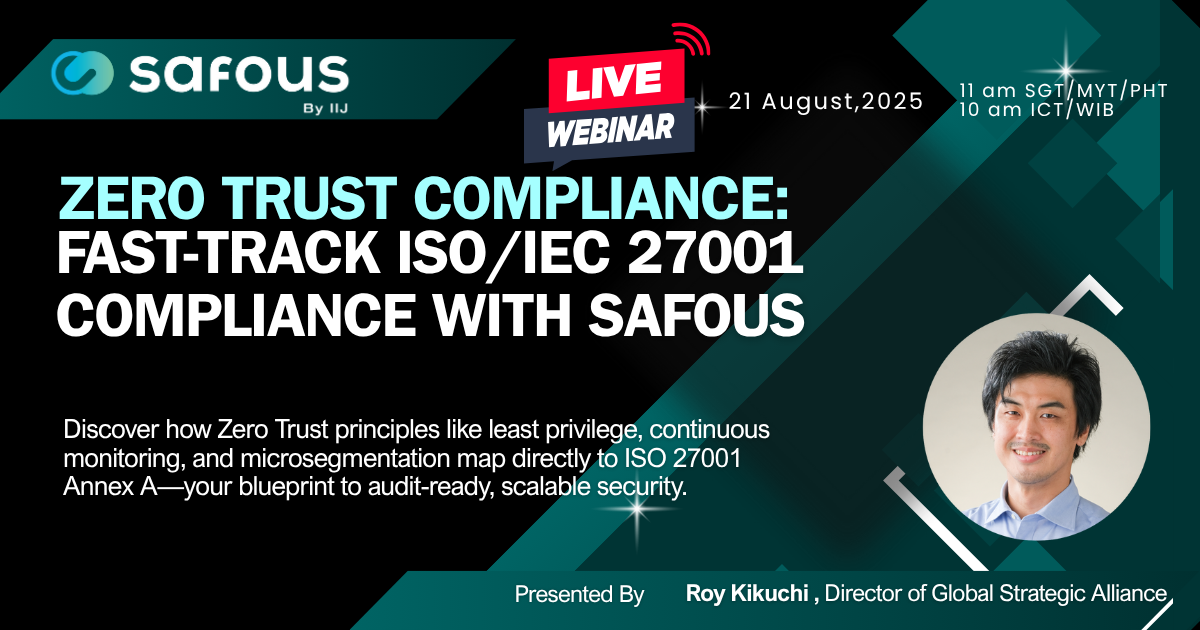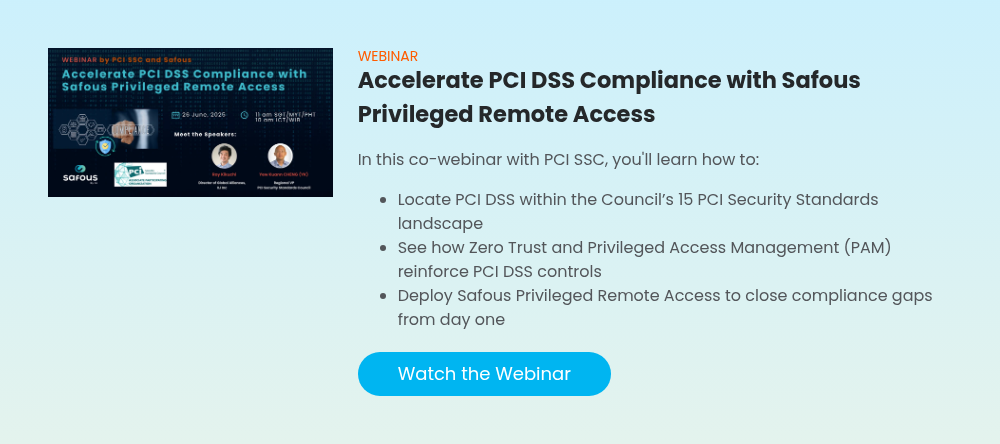The Payment Card Industry Data Security Standard (PCI DSS) has released its newest version, 4.0.1, bringing some of the most significant updates to payment card security in years. It’s no longer just about ticking boxes – it’s about maintaining strong, continuous security practices in a landscape where third-party access, hybrid work, and targeted attacks are all on the rise.
For organizations that handle cardholder data (CHD), complying with PCI DSS 4.0.1 has become a strategic imperative. But without a dedicated Remote Privileged Access Management (PAM) solution, many still struggle to enforce and audit third-party access at scale.
In this blog, we’ll explain what’s changed in PCI DSS 4.0.1, the challenges businesses face during implementation, and how a zero-trust Remote PAM solution like Safous can make achieving compliance easier.
What’s New in PCI DSS 4.0.1?
Compared to version 3.2.1, PCI DSS 4.0.1 is more flexible but also more demanding. Instead of mandating prescriptive controls, it introduces outcome-based security objectives – meaning organizations now have more freedom in how they meet requirements, but also more responsibility to prove those measures work.
Some of the biggest updates include:
- Multi-factor authentication (MFA) for all access to cardholder data environments
- Ongoing validation through continuous assessments
- Stricter scrutiny on vendor and supply chain security
For businesses that rely on third parties, remote access, or legacy infrastructure, these changes can make compliance feel overwhelming if you don't have the right tools in place.
Challenges in Achieving PCI DSS 4.0.1 Compliance
PCI DSS 4.0.1 raises the bar in terms of accountability, introducing challenges such as:
Complex Requirements
Organizations must secure every system that stores, processes, or transmits CHD. That’s a broad scope, and without a centralized Remote PAM solution, it’s hard to control who’s accessing what.

Resource-Intensive Audits
Maintaining compliance now requires regular risk assessments, vulnerability scans, and penetration testing. These activities take time, tools, and expertise that many organizations don’t have readily available, adding to the operational burden.
Third-Party Access Risks
Vendors often need privileged access to systems, which increases the risk of breaches. In fact, a 2025 report found that 47% of businesses experienced a data breach that involved third-party access last year.1
Legacy System Compatibility
Many organizations still rely on outdated VPNs and access models that weren’t built with today’s security expectations in mind. Trying to layer compliance controls on top of this outdated architecture only adds to the complexity.
How Does Zero Trust Simplify Compliance?
The Zero Trust security model simplifies compliance. It's a proactive framework that assumes no user, device, or session should be trusted automatically, aligning seamlessly with the objectives of PCI DSS 4.0.1.
Zero Trust supports PCI DSS controls in several ways:
- Identity and Access Management (IAM): Verifies users and devices continuously, ensuring only authorized entities can access cardholder data.
- Least Privilege Access: Grants users only the access they need, limiting exposure and reducing risks like internal threats and lateral movement.
- Micro-Segmentation: Isolates workloads and systems, preventing attackers from moving freely across the network.
- Audit and Visibility: Provides real-time insight into security events via centralized logging, monitoring, and analytics.
Implementing Zero Trust isn't just a security philosophy; it’s a compliance enabler that can help your organization meet PCI DSS goals more quickly and efficiently.
4 Ways Safous Supports PCI DSS 4.0.1 Requirements
Safous offers a Privileged Remote Access solution that simplifies PCI DSS 4.0.1 compliance by applying Zero Trust principles at every access point. Here’s how:
1. Reduced PCI DSS Scope Through CHD Avoidance
Safous never stores or processes CHD through its platform. Instead, remote sessions are isolated, and sensitive activities are routed without touching CHD environments. This helps reduce the number of systems requiring compliance validation, saving time and cost.
2. Agentless Access for Seamless Integration
Unlike traditional solutions that rely on endpoint agents, Safous provides secure, browser-based access with no installation required. This ensures compatibility across legacy systems and industrial control environments, reducing overhead for IT teams and minimizing attack surfaces.
3. Secure Privileged Access With Fine-Grained Control
Safous integrates advanced Privileged Access Management (PAM) capabilities to enforce Zero Trust across all privileged sessions. Features like Just-In-Time (JIT) access, mandatory MFA, and role- and attribute-based policies ensure that administrative access is tightly controlled and fully auditable.

4. Comprehensive Session Monitoring and Audit Logs
PCI DSS 4.0.1 requires organizations to log and monitor all access to the CDE. Safous makes audit readiness easy with command-level logging, optional session recording, and customer-side storage for logs and recordings.
Other Benefits of Implementing Safous
Businesses across various industries, from finance and retail to healthcare and manufacturing, choose Safous because it delivers on three core promises:
- Security: Built on a Zero Trust architecture, Safous defends against modern attack vectors like credential theft, VPN exploitation, and insider threats.
- Simplicity: Features like agentless deployment, seamless integrations, and intuitive policy management simplify operations.
- Compliance: Safous is fully aligned with PCI DSS 4.0.1 and other global frameworks like the CISA Zero Trust Maturity Model and NIST Cybersecurity Framework.
Whether you’re just starting your PCI DSS journey or migrating from 3.2.1 to 4.0.1, Safous helps you get compliant and stay that way.
Prepare for Continuous Compliance With Remote PAM
The deadline for migrating to PCI DSS 4.0.1 is approaching quickly, so it’s time to prioritize a smooth and secure transition to the new security measures. Here’s how Safous and a PCI-qualified security assessor (QSA) partner can support your journey:
- Conduct a PCI DSS 4.0.1 Gap Assessment: Determine where your current practices fall short of new compliance requirements.
- Build a Custom Implementation Roadmap: Create a plan to adopt stronger security controls without disrupting business operations.
- Train Your Teams: Educate your key stakeholders on evolving threats, Zero Trust strategies, and PCI DSS expectations.
- Test Rigorously: Validate system configurations and user behaviors through simulations and red team exercises.
- Align Vendor Access: Use tools like Safous to manage third-party access and maintain full compliance with PCI DSS.
- Prepare for Continuous Compliance: Leverage Safous’ logging and reporting capabilities to support year-round compliance, not just annual audits.
With these strategies in place, you’re not just meeting PCI DSS 4.0.1 requirements – you’re building a more resilient security posture for the long term.
Ready to get started with a practical, Zero Trust-aligned solution designed for businesses looking to reduce scope, secure privileged access, and deliver audit-ready evidence with confidence? Reach out to Safous today.
Sources:
Receive the latest news, events, webcasts and special offers!
Share this
You May Also Like
These Related Stories

What Is Universal ZTNA?

How Safous Redefines RPAM to Combat Deepfake Attacks






